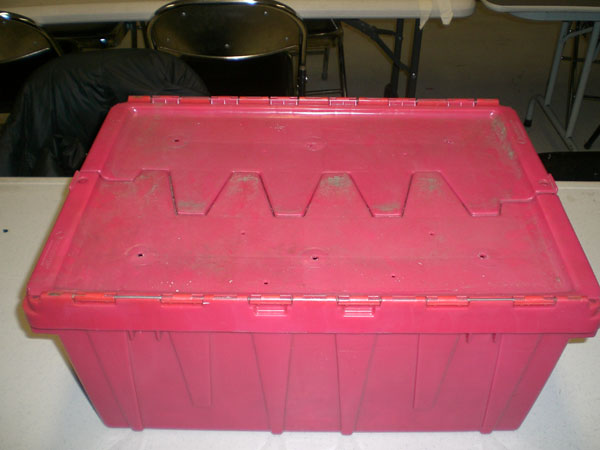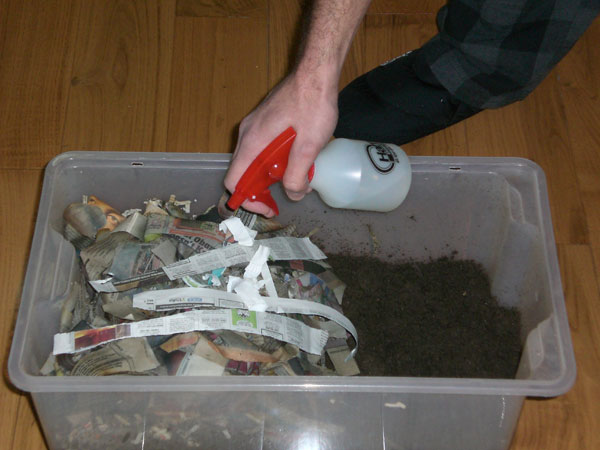Vermicomposting: Zero Waste = A Vibrant Garden
By Wendy Tremayne
Daniel Tainow wishes to reunite fungus, bacteria, and invertebrate communities with the human communities of gardeners, eaters, and wearers of clothing. Tainow is the Compost Project Coordinator of the Queens Botanical Garden located in New York. He envisions a future in which there is no difference between the natural and the human realms. The actualization of this vision begins with compost. According to Tainow, composting natural fibers at home offers the realization that we are an important part of the cycles of life.
If you consider that everything that was once alive can be composted, it is remarkable how little actually gets composted. To name a few items: paper, human waste, hair, dryer/bellybutton lint, people, sheet rock, animals, vegetable and plant material, and natural fibers can all be returned to nutrients that revitalize the earth. This zero-waste loop can be started in about half an hour with little to no money spent.
To prepare for this project, you might go back in time and muster up the thrill you felt when animating sea monkeys from strange powders or watching Chia Pets spring to life from a splash of water. Imagine encouraging life for the perpetuation of life instead of for the thrill of manipulating it. Welcome to 21st-century thinking.
As makers of things, we know that life is as interesting as our interest in it. And recycling at home offers a fascinating and educational view of the process of transformation from waste to life. According to Tainow, “Composting immediately reduces household waste by 25% to 50%” and “triggers a chain of events: the reduction of carbon emissions from petroleum-burning trucks and their delivery of heat-trapping waste that produces methane and water-contaminating leachate to landfills.” If you have a food-growing garden, homegrown compost will also reduce your exposure to toxins through chemical fertilizers that are used on much of the food we buy in stores. But perhaps the greatest gain is the experience of reconnecting with the natural world. Welcome home.
Once started, your compost equips you to be the bringer of life as you gift your harvest to anyone with a potted plant or garden. Compost cookies (compost rolled and compressed into cookie shapes and dried) make wonderful DIY gifts. If you’ve ever enjoyed guerrilla gardening (tossing balls of seeds and earth into vacant plots of land) you might consider guerrilla composting too.
Materials
Plastic bin with lid about 8" to 16" deep, with about 2 square feet of bottom
Worms Red wigglers work best.
Paper and cloth to shred
Drill with a 1/5" bit
Make a Worm Bin
1. Choose a bin 8" to 16" deep with about 2 square feet of bottom.
2. Drill 10 to 20 1/5" holes in the top of the bin. Worms and beneficial bacteria need oxygen for decomposition.
3. Shred paper and cloth to less than 1" strips and fill the bin loosely. Newspaper and paper run through a shredder are ideal. Avoid glossy, brightly colored paper and plastic envelope windows. Do not exceed a 50:50 fiber-to-paper ratio. Too much fiber will mat and suffocate the bin. This bedding helps the worms absorb excess moisture, and provides carbon-rich material to balance the nitrogen in food waste.
4. Moisten the bed with a spray bottle or by dunking and wringing the paper and fiber. A dry worm is a dead worm. Worms breathe through their moistened skin.
5. Add the worms. Red wigglers from a worm farmer are ideal. Do not use night crawlers (found in your yard) as they won’t enjoy bin life because they burrow deep into the ground.
6. Feed your worms. Bury your kitchen scraps under a couple inches of bedding to avoid inviting fruit flies. A pound of worms will decompose up to half a pound a day of your fruit and vegetable scraps, tea, and coffee. Avoid animal products and oily foods that encourage odors and pests.
7. When you no longer recognize food or bedding and everything appears crumbly and brown, your compost is ready for harvesting. Push the bedding aside, scoop out the compost, pick out worms that are mixed in, and place them back into your bin. If your compost is for a home garden, its OK to let some worms come along.
8. Add compost to house plants, gardens, and neighborhood street trees or make compost cookies for gifts.
Learn more at the Holy Scrap Hot Springs blog.
About the Author:
Wendy Tremayne is renovating an RV park into a 100% reuse, off-grid B&B in Truth or Consequences, N.M. Another project, Swap-O-Rama-Rama, is a clothing swap and DIY workshop designed to offer people an alternative to consumerism.
ADVERTISEMENT














